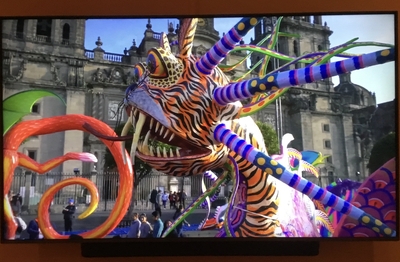Santa Fe, N.M.
The ingredients sound so ordinary: paper, paste, cane, wire, molds and paint. From these simple materials, Mexican folk artists have created the enchanting world in "La Cartonería Mexicana | The Mexican Art of Paper and Paste" at the Museum of International Folk Art. More than 100 colorful objects—dolls, animals, devils, Judas figures, dragons and especially skeletons—line the walls, fill the platforms, and hang from the ceiling in an exhibition that is as much about Mexican culture as it is about folk art. A 5-foot-tall Frida Kahlo figure (2006) even makes an appearance, fittingly, because by displaying cartonería objects in her Blue House Kahlo helped turn them into collectibles, spawning more creativity.
 Winged dragon alebrije by Pedro Linares |
 Mexico City parade |
Carnival means parades and dancing, with participants dressing like royalty or maybe animals. They may wear masks like those in a display, depicting a black cat, a white rabbit and a yellow leopard, or hats topped by a rooster, a dog or similar figures (all, c. 1960).
 Flying Devil |
The feast of Corpus Christi, which honors the belief that Jesus is present in the Eucharist, comes about two months after Easter, bringing toys for children. The sampling on view includes a magenta bull (1994) by Bernardino Lemus; pull-toys in the form of a duck and a horse (both c. 1960), and rattles of many colors, kinds and dates. The Day of the Dead takes over around Halloween. As Mexicans gather at tombs of loved ones or at home altars, humorous skeletons and skull candy appear everywhere—here, too. Four grinning skeletons clothed in blue (1990) by David Moctezuma play guitars, a violin and a trumpet. Another item by Mr. Moctezuma portrays a rootin' tootin' cowboy brandishing pistols (1990). And a female skeleton (c. 1965), in an orange dress, hat and gloves, wields her orange handbag as if to say "Stay away."
 A peddler |
The final section reveals how creative artisans grew after cartonería attracted collectors. In particular, Pedro Linares López (1906-1992) and his descendants devised fantastical, multicolored creatures that combine parts of many animals and gave them a fictional name: "alebrijes." Among the amusing ones on view are a bug-eyed, stripe-tailed monster-dragon and a winged, double-skulled dragon (both 1990, by the Linares family) decorated in pinks, blues, greens and other colors.
 "Skeleton Figure" |
"La Cartonería Mexicana" telegraphs the opposite for these sculptures, especially the alebrijes. They have found a place in the art world and, as seen in a short video that captures float-sized cartonería navigating crowd-thronged Mexico City streets in the annual "Alebrije Parade," they seem ensconced in the popular world, too. Rightfully.

